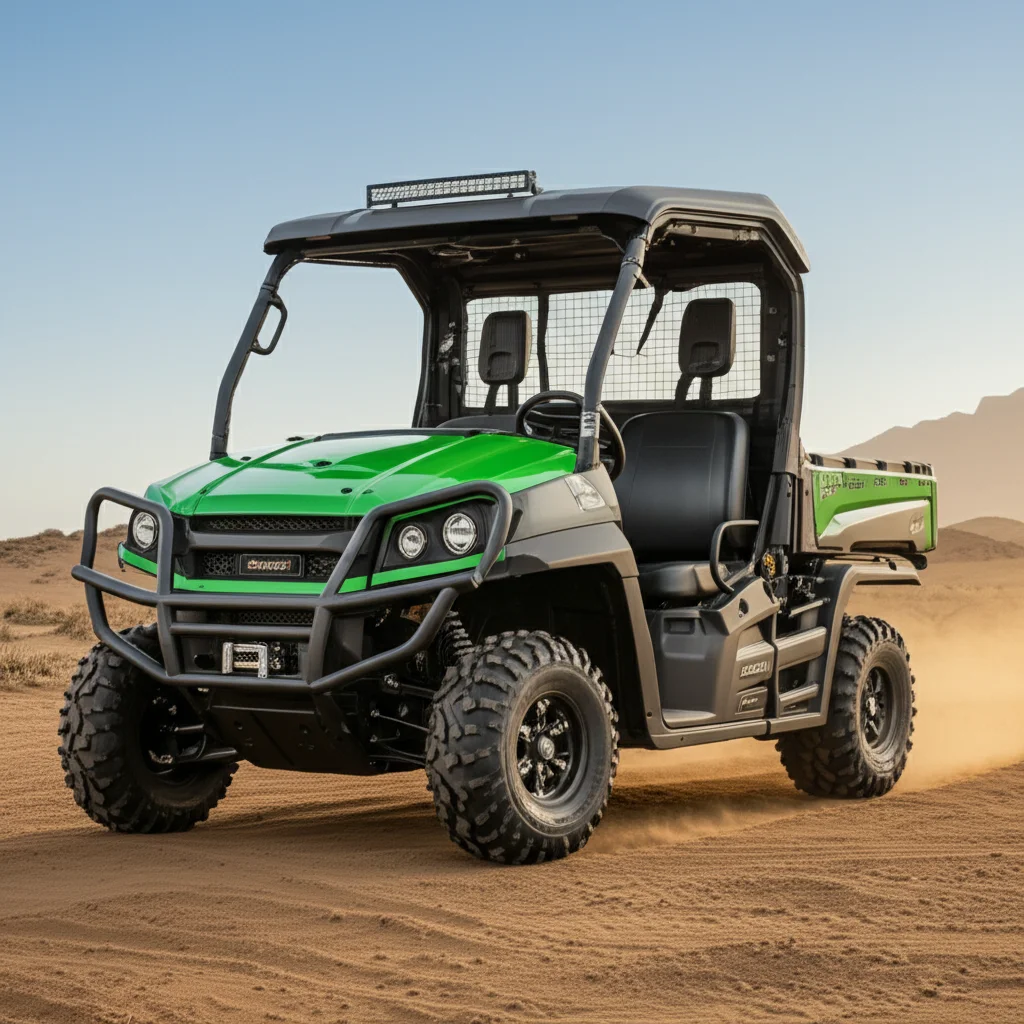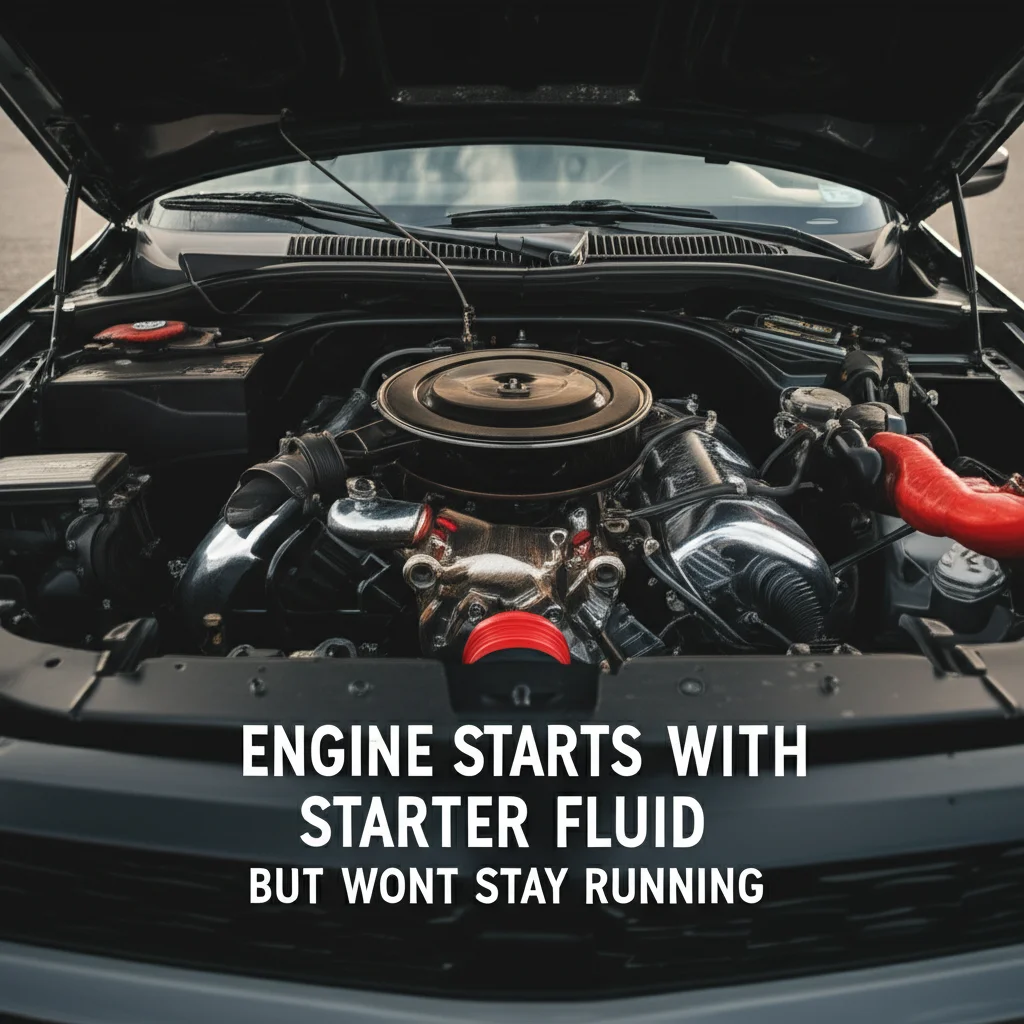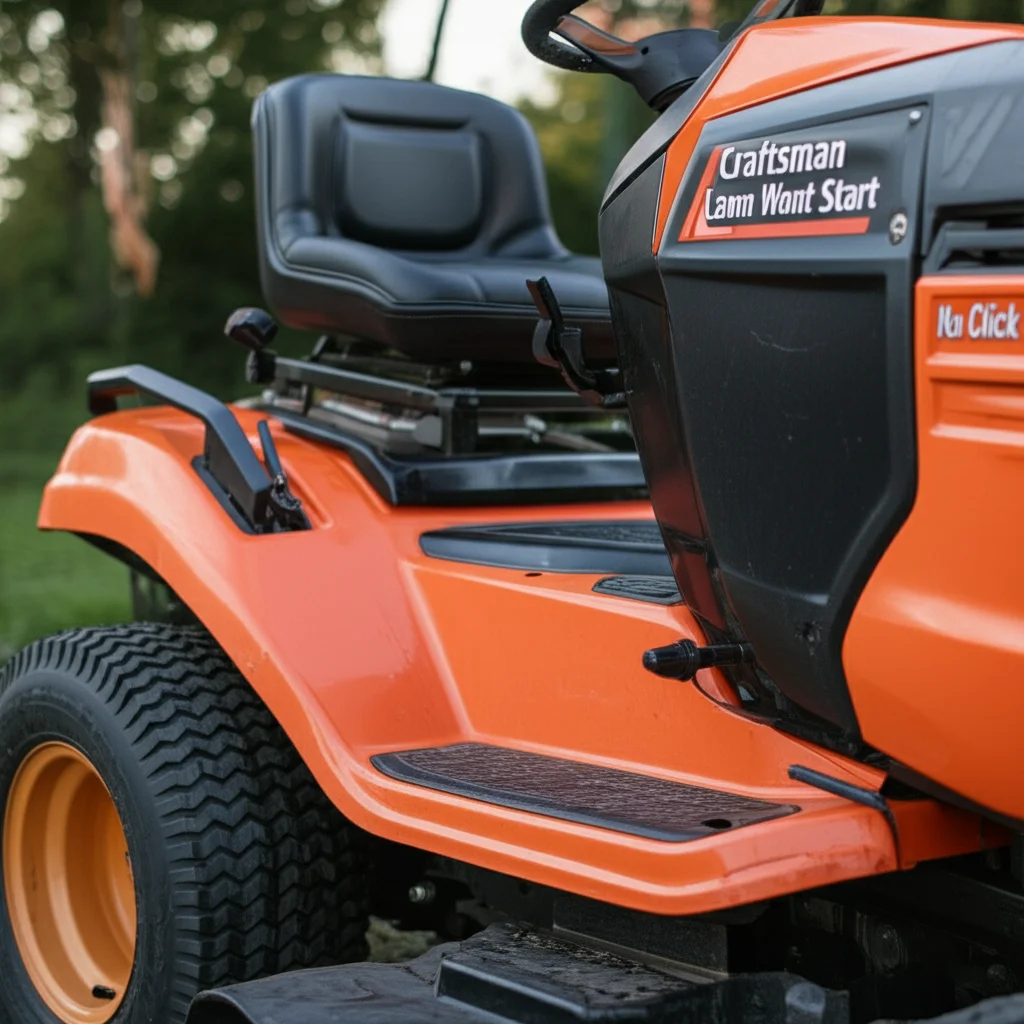· ATV & UTV Repair · 14 min read
Kawasaki Mule Turns Over But Wont Start

Kawasaki Mule Turns Over But Won’t Start: Troubleshooting Guide
When your Kawasaki Mule turns over but won’t start, it can be incredibly frustrating, especially when you need your utility vehicle for work or recreational activities.
This comprehensive troubleshooting guide will walk you through the most common causes and solutions for this problem, helping you get your Kawasaki Mule back on the trails or job site quickly and efficiently.
Key Takeaways
• Fuel system issues are the most common cause when a Kawasaki Mule cranks but won’t start
• Ignition problems including faulty spark plugs or ignition coils frequently prevent starting
• Air filter blockages can restrict airflow and prevent proper engine combustion
• Battery and electrical issues may cause insufficient power for ignition
• Regular maintenance prevents most starting problems before they occur
• Systematic diagnosis helps identify the exact cause quickly and cost-effectively
Quick Answer: When your Kawasaki Mule turns over but won’t start, the issue typically stems from fuel delivery problems, ignition system failures, or air intake restrictions. Check fuel quality, spark plugs, air filter, and electrical connections first.
Understanding the Problem: Why Your Kawasaki Mule Won’t Start
When your Kawasaki Mule engine turns over but fails to start, it indicates that the starter motor and battery are functioning correctly, but something is preventing the engine from achieving combustion. For an engine to run properly, it needs three essential elements: fuel, air, and spark. If any of these components are compromised, your Mule will crank but refuse to fire up.
The turning over action confirms that your electrical system has enough power to engage the starter motor. However, the lack of ignition suggests problems with fuel delivery, air intake, or the ignition system itself. This distinction is crucial because it helps narrow down the troubleshooting process significantly.
Many Kawasaki Mule owners experience this issue across different models, including the Mule 610, Mule 4010, and Mule Pro FXT. Understanding the common causes can save you time and money on unnecessary repairs while getting your utility vehicle back to working condition.
Common Fuel System Issues
Contaminated or Stale Fuel
Fuel-related problems are among the most frequent causes when a Kawasaki Mule cranks but won’t start. Gasoline can become stale after sitting for extended periods, typically 30-60 days, especially during off-seasons. Stale fuel loses its combustibility and can gum up fuel lines and injectors.
Contaminated fuel containing water, dirt, or debris can also prevent proper engine operation. Water in fuel is particularly problematic as it can cause corrosion in fuel system components and prevent proper combustion. If your Mule has been sitting unused for months, fuel contamination should be your first suspect.
To address fuel issues, drain the existing fuel completely and replace it with fresh gasoline. Use fuel stabilizer if you plan to store your Mule for extended periods. Consider running the engine dry before long-term storage to prevent fuel system problems.
Clogged Fuel Filter and Lines
A clogged fuel filter restricts fuel flow to the engine, preventing adequate fuel delivery for combustion. Kawasaki Mules have inline fuel filters that capture debris and contaminants but can become blocked over time. Similarly, fuel lines can develop restrictions due to debris buildup or collapsed internal walls.
Signs of fuel filter problems include intermittent running issues before complete failure to start. The engine may have run poorly or hesitated during acceleration before reaching the point where it won’t start at all. Regular fuel filter replacement, typically every 100-200 hours of operation, prevents most fuel delivery issues.
Inspect fuel lines for kinks, cracks, or visible debris. Replace any damaged lines and ensure all connections are secure. A fuel system cleaning may be necessary if contamination is widespread throughout the system.
Fuel Pump Problems
Modern Kawasaki Mules rely on electric fuel pumps to deliver gasoline from the tank to the engine. When fuel pumps fail, they may still make noise but fail to generate adequate pressure for proper fuel delivery. A failing fuel pump often provides intermittent service before complete failure.
Testing fuel pump operation requires checking fuel pressure at the rail or testing for electrical continuity at the pump connections. You should hear the fuel pump priming when you turn the key to the “on” position before starting. If you don’t hear this priming sound, electrical or pump issues are likely.
Fuel pump replacement typically requires dropping the fuel tank or accessing the pump through a service panel, depending on your Mule model. This repair often requires mechanical expertise and proper tools for safe completion.
Ignition System Troubleshooting
Spark Plug Inspection and Replacement
Faulty spark plugs are a leading cause of starting problems in Kawasaki Mules. Even if spark plugs appear functional, they may not generate sufficient spark intensity for reliable ignition. Carbon buildup, oil fouling, or electrode wear can prevent proper spark formation.
Remove each spark plug and inspect for obvious damage, excessive carbon deposits, or oil contamination. The electrode gap should meet manufacturer specifications, typically around 0.7-0.8mm for most Kawasaki Mule engines. Use a spark plug tester to verify each plug produces a strong blue spark.
Replace spark plugs if they show signs of wear, damage, or contamination. Use the manufacturer-recommended spark plug type and gap specification. New spark plugs are inexpensive insurance against starting problems and should be replaced according to maintenance schedules.
Ignition Coil Testing
Ignition coils transform low-voltage battery power into high-voltage electricity needed for spark plug operation. When ignition coils fail, they may produce weak or inconsistent spark, preventing reliable engine starting. Coil failure often occurs gradually, causing intermittent starting issues before complete failure.
Testing ignition coils requires a multimeter to check primary and secondary resistance values. Compare readings against manufacturer specifications to determine if coils are functioning properly. Visual inspection may reveal obvious damage like cracked housing or corroded connections.
Ignition coil replacement is typically straightforward but requires careful attention to wire routing and connections. Ensure all electrical connections are clean and secure before testing the repair. Poor connections can cause new coils to fail prematurely.
ECU and Sensor Issues
Modern Kawasaki Mules incorporate electronic control units (ECUs) and various sensors that monitor engine conditions. Faulty sensors can prevent the ECU from providing proper ignition timing or fuel delivery commands. Common problematic sensors include crankshaft position sensors, throttle position sensors, and temperature sensors.
Diagnostic trouble codes can often identify specific sensor problems, but require appropriate scan tools for retrieval. Some Kawasaki Mules have built-in diagnostic modes accessible through specific key sequences or button combinations. Consult your owner’s manual for model-specific diagnostic procedures.
Sensor replacement typically requires basic mechanical skills but demands careful attention to connector integrity and wire routing. Clean all connections thoroughly and apply dielectric grease to prevent corrosion. Similar to Kawasaki lawn engine turns over but won’t start issues, electronic components need proper maintenance.
Air Intake and Filtration Problems
Clogged Air Filter Issues
A severely clogged air filter restricts airflow to the engine, preventing proper air-fuel mixture formation necessary for combustion. While minor air filter restriction may cause poor performance, complete blockage can prevent starting altogether. This issue is particularly common in dusty operating environments.
Inspect the air filter for obvious debris, dirt accumulation, or damage. A dirty air filter often appears gray or black instead of white or light colored. Hold the filter up to light to check for blockages - you should see light through a clean filter.
Clean reusable foam filters with mild soap and water, allowing complete drying before reinstalling. Replace paper filters when dirty, as cleaning typically damages their filtering media. Regular air filter maintenance prevents most air intake problems and improves overall engine performance.
Intake Manifold and Throttle Body
Intake manifold leaks allow unmeasured air into the engine, disrupting the proper air-fuel mixture needed for combustion. These leaks often develop at gasket surfaces or where vacuum lines connect to the manifold. Throttle body issues, including carbon buildup or stuck throttle plates, can also prevent proper air intake.
Inspect all vacuum lines for cracks, loose connections, or deterioration. Check intake manifold gaskets for obvious damage or displacement. Listen for hissing sounds that might indicate vacuum leaks while the engine is cranking.
Throttle body cleaning may resolve issues caused by carbon deposits or sticky residue. Use appropriate throttle body cleaner and avoid damaging sensitive sensors or coatings. Some throttle bodies require specific relearning procedures after cleaning or replacement.
Battery and Electrical System Diagnosis
Battery Condition and Connections
While a Kawasaki Mule that turns over indicates adequate battery power for the starter motor, insufficient voltage can still prevent ignition system operation. Weak batteries may provide enough current for cranking but lack the sustained power needed for fuel pumps, ignition coils, and engine management systems.
Test battery voltage with a multimeter - a healthy 12-volt battery should read 12.6 volts or higher when the engine is off. During cranking, voltage should not drop below 10.5 volts. Clean battery terminals and cable connections, as corrosion can create resistance that limits electrical flow.
Check battery cable condition for internal corrosion or damage that might create high resistance connections. Replace damaged cables and apply protective coating to prevent future corrosion. Consider battery replacement if it’s more than 3-4 years old or fails load testing.
Starter and Charging System
Although the starter motor operates when the engine turns over, internal starter problems can affect cranking speed and quality. Insufficient cranking speed may prevent the engine from achieving the compression and timing needed for ignition. Similarly, charging system problems can gradually weaken the battery.
Test cranking speed by observing how quickly the engine turns over compared to normal operation. Slow cranking often indicates starter motor problems, excessive engine resistance, or inadequate battery condition. Listen for unusual noises during cranking that might indicate mechanical problems.
Charging system testing requires measuring alternator output while the engine runs. However, since your Mule won’t start, focus on battery and starter system diagnosis first. Address charging system concerns after resolving the starting problem to prevent future battery issues.
Step-by-Step Troubleshooting Process
Initial Quick Checks
Begin troubleshooting with the most common and easily checked items. Verify fuel level in the tank - running completely out of gas can cause air to enter fuel lines, requiring priming for restart. Check that the fuel shutoff valve is in the “on” position if your model has one.
Ensure the transmission is in park or neutral, as safety interlocks prevent starting in gear. Check that the parking brake is engaged if required by your model’s safety system. These simple checks resolve many apparent starting problems without mechanical diagnosis.
Listen carefully during cranking attempts for unusual sounds, fuel pump operation, or changes in cranking speed. These audio clues often point toward specific problem areas and help focus troubleshooting efforts efficiently.
Systematic Component Testing
Follow a logical sequence when testing components to avoid duplicating efforts or missing critical issues. Start with fuel system checks since these are most common, then move to ignition system testing, and finally address air intake and electrical issues.
Test one component completely before moving to the next area. Keep notes of test results and observations to track your progress and avoid repeating tests. This systematic approach identifies problems efficiently while building understanding of your Mule’s systems.
Consider the interconnected nature of engine systems - fuel injection problems might actually stem from electrical issues, while ignition problems could be caused by sensor malfunctions. Understanding these relationships helps identify root causes rather than just symptoms.
When to Seek Professional Help
Some diagnostic procedures require specialized tools or expertise beyond typical owner capabilities. Fuel system pressure testing, ECU diagnostics, and internal engine problems often need professional attention. Don’t hesitate to consult a qualified technician when troubleshooting exceeds your comfort level.
Professional diagnosis can actually save money by quickly identifying complex problems that might take hours of trial-and-error troubleshooting. Technicians have access to specialized diagnostic equipment and technical bulletins that can expedite problem resolution.
Consider professional help if you’ve systematically checked fuel, ignition, and air intake systems without finding the problem. Internal engine issues, while less common, do occur and require expert diagnosis and repair capabilities.
Prevention and Maintenance Tips
Regular Service Schedule
Preventive maintenance significantly reduces starting problems and extends your Kawasaki Mule’s service life. Follow manufacturer-recommended service intervals for oil changes, filter replacements, and system inspections. Regular maintenance catches developing problems before they cause starting failures.
Keep detailed maintenance records to track service history and identify patterns in component failures. This information helps predict when components might need attention and can be valuable for warranty claims or resale purposes.
Consider seasonal maintenance routines that address storage-related problems before they occur. Pre-season preparation and proper storage procedures prevent many common starting issues associated with extended periods of non-use.
Storage Best Practices
Proper storage preparation prevents most fuel-related starting problems after extended periods of non-use. Add fuel stabilizer to a full tank of fresh gasoline before storage to prevent fuel degradation and water accumulation. Run the engine briefly to circulate treated fuel through the system.
Battery maintenance during storage includes either removing the battery for indoor storage or connecting a battery tender to maintain proper charge levels. Extreme temperatures and extended periods without charging can permanently damage batteries.
Protect your Mule from moisture and rodents during storage, as both can cause significant damage to electrical systems and mechanical components. Use appropriate covers and consider rodent deterrents in areas where infestations are common.
Quality Parts and Fluids
Use manufacturer-recommended or equivalent quality parts and fluids to ensure reliable operation and prevent premature failures. Cheap aftermarket parts may save money initially but often fail sooner and can cause secondary damage to related components.
Quality fuel makes a significant difference in engine performance and longevity. Use top-tier gasoline when possible and avoid ethanol blends higher than E10 unless specifically approved by Kawasaki. Poor fuel quality contributes to many starting and performance problems.
Regular oil changes with appropriate oil viscosity and quality protect internal engine components and ensure proper operation of hydraulic valve systems that affect timing and compression. Don’t extend oil change intervals beyond manufacturer recommendations.
Frequently Asked Questions
Why does my Kawasaki Mule turn over but not start after sitting for months? Stale fuel is the most likely culprit when a Mule won’t start after extended storage. Gasoline degrades over time, losing combustibility and potentially forming deposits that clog fuel system components. Drain old fuel, replace with fresh gasoline, and check the fuel filter for clogs.
What should I check first when my Kawasaki Mule 610 cranks but won’t start? Start with fuel system checks including fuel level, fuel quality, and fuel filter condition. Then verify spark plug condition and air filter cleanliness. These three areas account for most starting problems and are relatively easy to inspect and service.
How can I tell if my Kawasaki Mule’s fuel pump is working? Listen for a brief humming sound from the fuel tank area when you turn the key to “on” before starting. This priming sound indicates the fuel pump is operating. You can also check for fuel pressure at the fuel rail, though this requires proper gauges and safety precautions.
What does it mean when my Kawasaki Mule clicks but won’t turn over? Clicking without cranking typically indicates insufficient battery power or poor electrical connections. Test battery voltage and clean all battery connections. This differs from turning over but not starting, which suggests fuel, air, or ignition problems rather than electrical issues.
Can bad gas cause my Kawasaki Mule to crank but not start? Yes, contaminated or stale gasoline is one of the most common causes of cranking without starting. Bad fuel may not ignite properly or may clog fuel system components. Always use fresh fuel and consider adding fuel stabilizer if the Mule will sit unused for extended periods.
How often should I replace spark plugs in my Kawasaki Mule? Most Kawasaki Mules require spark plug replacement every 100-200 hours of operation or annually, whichever comes first. However, operating conditions affect spark plug life - dusty environments or poor fuel quality may require more frequent replacement.
What are signs that my Kawasaki Mule needs professional diagnosis? Seek professional help if systematic troubleshooting of fuel, ignition, and air intake systems doesn’t identify the problem. Complex electrical issues, internal engine problems, or situations requiring specialized diagnostic equipment typically need professional attention for efficient resolution.
Final Words
When your Kawasaki Mule turns over but won’t start, systematic troubleshooting focusing on fuel, ignition, and air intake systems will identify most problems efficiently.
Start with the most common issues like fuel quality and spark plugs before moving to more complex diagnostics. Regular maintenance prevents most starting problems and ensures reliable operation when you need your Mule most.
Remember that proper diagnosis saves time and money compared to random parts replacement.
If you’re not comfortable with certain troubleshooting procedures, don’t hesitate to consult a qualified technician.
Whether you’re dealing with a Kawasaki Mule 4010 that cranks but won’t start or any other model, following these systematic approaches will help restore your utility vehicle to reliable operation.
Take action today by checking your Mule’s basic maintenance items and addressing any identified issues before they leave you stranded on the trail or job site.
- Kawasaki Mule
- No Start
- UTV Repair
- Engine Troubleshooting
- Fuel System



